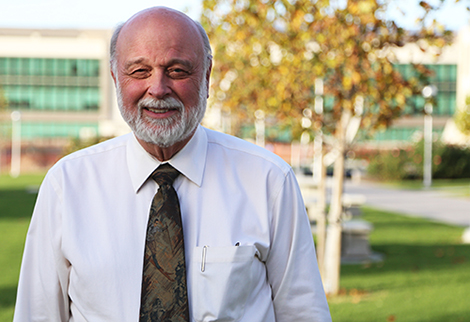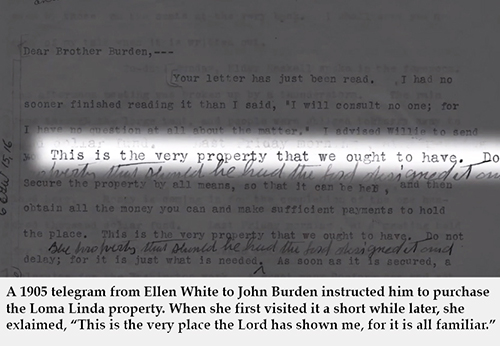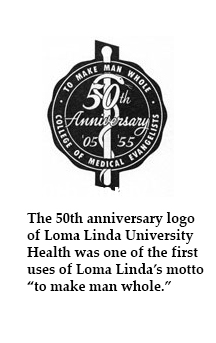I recognize that each of you reading this monthly news note comes from a different background and perspective. I must also assume the only common link between all of us is some kind of interest and relationship with Loma Linda University Health,  whether through working, studying, being treated as a patient, or a connection in some other way. I even assume that some of you may still wonder about Loma Linda — maybe as more of a critic than supporter. But if you keep reading, I want to try and explain a relationship that is very special.
whether through working, studying, being treated as a patient, or a connection in some other way. I even assume that some of you may still wonder about Loma Linda — maybe as more of a critic than supporter. But if you keep reading, I want to try and explain a relationship that is very special.
I have talked before about Loma Linda University Health’s remarkable beginnings. During the first few years after the property’s purchase in 1905, many problems plagued that intrepid little band of pioneers. But they had an indomitable belief that they were part of something bigger, something ordained by God Himself that was behind this institution. So when they met a problem that seemed larger than themselves, as they often did, they rarely questioned whether the whole premise of Loma Linda was misguided. Rather, they asked how God would see them through that particular issue. This mold was set at the very beginning when Ellen White, one of our founders, declared “This is the very place,” and there was no turning back.
Institutional character develops over time and is a complex implementation of founding principles molded by convicted leaders with a belief in destiny. Loma Linda University Health is no different, and over the century-plus of its existence, a culture has emerged that is well settled and unique.
First, the leaders of this place adopted an approach that was built on fundamental principles of Christianity, now notarized in our expanded core values — Compassion, Integrity, Excellence, Teamwork and Wholeness. Our commitment to wholeness became part of our stated culture at our golden anniversary in 1955 with the theme “to make man whole,” which soon became our motto. The past several decades have seen this concept of wholeness refined and codified with techniques for modeling and teaching it both on campus and elsewhere.
Most educational institutions in the United States were started by church groups. But many of them have followed one of two tracks through their own histories — creeping toward secularization until their church linkage is minimal or forgotten, or becoming a “Bible college” fostering apologetics for their particular set of religious beliefs.

Loma Linda University Health has chosen a third route, one that has not changed for the 110 years of our existence. We are as true to this mandate today as when we were founded. The strategies have not even changed much, with service learning, compassionate patient care, and a profound faith in God at their core. This is coupled with a belief that modern scientific knowledge, even in the health sciences, is compatible with ultimate truth as defined in the Bible.
So how does Loma Linda define, articulate and follow this unique road through history? Certainly part of this is our continuous relationship with our founding church. Seventh-day Adventist beliefs have undergirded a set of living principles that are visible on our campus. These include:
• Each individual is valued as a child of God, regardless of background or culture,
• A life of service to others is desirable and the only road to complete happiness,
• Personal health is both valuable and attainable by appropriate lifestyle practices,
• Relationships with both God and people are important and need to be nurtured, and
• Curiosity and the pursuit of knowledge and discovery are planted in us by God.
We don’t, indeed we can’t, assume this unique culture will just carry on by itself. So we very intentionally recruit students and faculty who share these beliefs. We design programs and experiences that nurture this understanding. We adopt policies that affirm these positions. We monitor our success in sharing and promoting these concepts with our students, patients and community. And we pray regularly that God will help us maintain this campus commitment.

As this newsletter is being distributed, many of us have just returned from the General Conference Session of the Seventh-day Adventist Church in San Antonio, Texas. This meeting occurs every five years and is a time of spiritual renewal, policy refinement, election of new leaders, theology review, and social connecting. With over 70,000 people attending, even the meetings are complex. The church itself now has some 18 million members, with 8,000 schools, including 112 colleges and universities, educating 1.7 million students. In health care, we have 175 hospitals and some 450 clinics around the world, caring for millions of patients, as well as many other programs and institutions. Meeting and doing business can easily become big business despite constant attempts to maintain a spiritual focus. Major issues were discussed as the church seeks to maintain unity in a broad collection of cultures and understanding. With 93 percent of membership now outside North America, mainly in the developing areas of the world, cultural differences are often striking and can influence voting on key issues in ways that seem outdated and disappointing for many of us in the western world.
Despite these concerns, I deeply value the culture this church has bequeathed to Loma Linda. It has and will continue to profoundly guide our decisions and development. We face challenges today that seem to rival even those of our pioneers, but we share their confidence in the divine destiny of this place. Pray that we may keep the focus and commitment to this incredible heritage.
Sincerely,
Richard Hart, MD, DrPH
President
Loma Linda University Health
“God’s little nation was His beachhead, not His boundary.”
–Derek Kinder
Vision 2020: The Campaign for a Whole Tomorrow